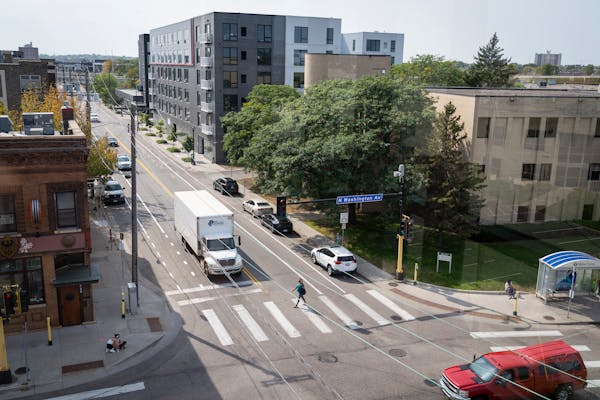Two cities that had reservations about approving plans to extend the Blue Line have given their consent to allow work on the $3.2 billion light-rail project to move forward.
City Councils in Robbinsdale and Crystal on Tuesday voted to support the light-rail plan, joining Brooklyn Park, Minneapolis and Hennepin County.
The affirmative votes from the cities and county along the line are a critical step as planning continues for the 13-mile line, which would run from downtown Minneapolis to Brooklyn Park beginning in 2030.
Required by state law, municipal consent calls for cities and counties along a proposed light-rail line to grant permission for the project to move forward. Withholding consent would not stop a project, but may require objecting cities to state what changes they would like before jumping on board.
"There is no legal authority to vote no and stop it," said Robbinsdale Mayor Bill Blonigan, who cast the deciding vote in a 3-2 decision.
With consent from the cities in hand, the project's route is firmly established. In Robbinsdale and Crystal, tracks will follow Bottineau Boulevard, also known as County Road 81. Tweaks to some elements can still be made once the project is 30% designed.
Robbinsdale has long been the wild card in the consent process.
Two weeks ago, the City Council tabled a vote, seeking changes that call for light-rail tracks to run down the center of Bottineau Boulevard. The city had asked for elevated tracks between 40th and 42nd avenues, a smaller park-and-ride ramp at 40th Avenue and raised concerns about station placement at Lowry Avenue near North Memorial Health Hospital.
In a Sept. 25 letter to the city, the Metropolitan Council, which will build the line, rejected the raised-track idea, but said current plans will "greatly enhance intersection design to maximize pedestrian safety" and move the 40th Avenue station to the north side of the intersection. The council also said ramp parking would be capped at 290 spaces and include a Metro Transit police substation, a nod to community concerns about crime on light-rail trains.
The council also said it will work with North Memorial and the city to address access and safety concerns with the Lowry Avenue station, which is on the border of Robbinsdale and Minneapolis.
The Minneapolis Park and Recreation Board, which does not vote on municipal consent, also expressed "major concerns" about the design and location of the Lowry Avenue station in an Aug. 12 letter to Blue Line project officials.
Park Board members are worried about how the at-grade design for light-rail trains will affect cyclists and pedestrians using the Wirth/Victory Memorial Parkway Regional Trail. The Park Board urged the council to explore "alternative design options."
These concerns were echoed Wednesday by Minneapolis City Council member LaTrisha Vetaw, whose ward includes Lowry station. Nonetheless, the Minneapolis City Council unanimously approved a motion to move forward with the project Wednesday.
Despite objections from some Robbinsdale residents who have lobbied to stop the project, Blonigan voted in favor of current designs, saying "we had gotten the best we were going to get, and we will get more in cooperation than by having an adversarial relationship" with the Met Council.
Blonigan hinted last month that he'd vote no with conditions, but in recent weeks he changed his mind. That didn't sit well with Karen Shull and other members of SLR81.org, a group of citizens opposed to the line running on Bottineau Boulevard.
"It's disappointing that the mayor did not listen," Shull said, alluding to a city survey that found 77% of respondents opposed light rail on Bottineau. Shull said SLR81.org started with hopes the city or Met Council could find a better route, or change course and opt for bus rapid transit.
"That is a slap in the face to people who have lived here for many years. He seemed most concerned in pleasing [Hennepin County Commissioners] Jeff Lunde and Irene Fernando," Shull said.
Blonigan, 70, has served on the City Council for 44 years and was elected mayor in 2020. He plans to retire when his term ends at the end of the year. He told residents opposing the extension that their objections were heard and vetted.
"This does not mean you were not listened to or that your concerns were not addressed," the mayor said.
Pockets of opposition also surfaced in Minneapolis, including some community members and businesses in north Minneapolis concerned about being displaced, and in the North Loop, where residents along 10th Avenue N. worry about the proximity and safety of light-rail trains near their homes.
In addition, two major Xcel Energy underground electric transmission lines will need to be moved to make way for the Blue Line.
Minneapolis City Council Member Michael Rainville, who represents the North Loop, said he was opposed to the Blue Line until recently due to concerns from the residents living near it, and crime aboard light rail. But, he said, after a recent conversation with Met Council Chair Charlie Zelle, he said he feels like his voice was heard.
The Hennepin County Board, which is paying roughly half the cost to build the project, unanimously granted consent on Tuesday.
In a statement following the Minneapolis vote Wednesday, Board Chair Fernando said the Blue Line extension represents "a historic investment in communities that have been historically underinvested in.
"This project is about our future and the type of community we want to build together. It's important that we get it right," she said. "There's still a lot of work to do."

University of Minnesota is putting its golf course up for sale
Supreme Court allows DOGE team to access Social Security systems with data on millions of Americans

Thompson found guilty of murder in car crash that killed 5 young women
Feeding Our Future probe: Apple Valley woman charged with defrauding food program of $1.4 million

